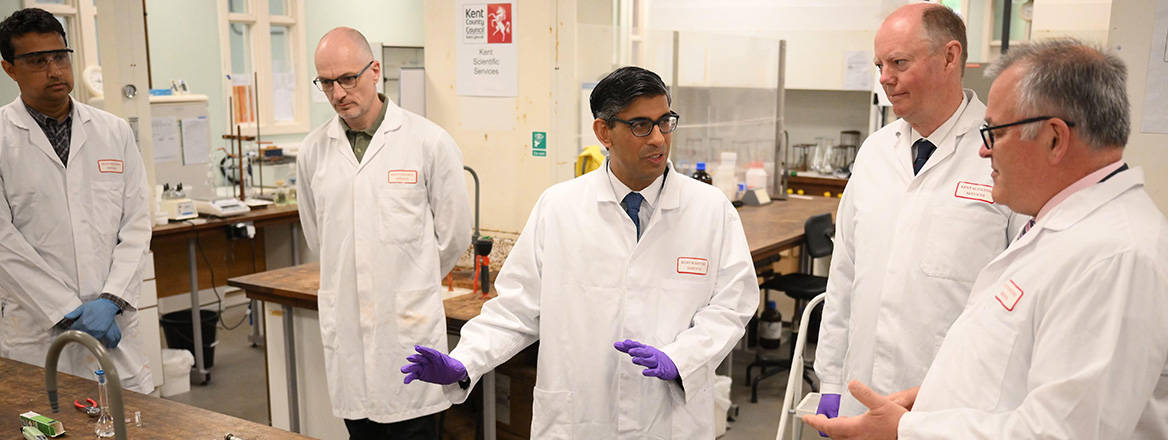Can the UK be a ‘Science and Technology Superpower’?
The government’s aim is for the UK to be a science and technology superpower. However, the UK’s current science and technology policy is based on three fallacies that limit its ability to become a tech superpower.
The UK government’s ‘science and technology superpower’ slogan may be an uneasy mixture of policy goal and branding strategy, but UK science is indeed world-class in terms of share of global citations and share of highly cited scientific papers, and the UK is a major exporter of higher education and a major trainer of the world’s scientists.
However, the UK is certainly not world-leading in terms of research and development (R&D) spending as a proportion of GDP, although nor is it a laggard. And the UK appears to be stuck in a particularly acute low productivity trap, with significant and persistent inter-regional disparities. This suggests that science and technology are not currently delivering superpowered outcomes.
Meanwhile, science, technology and innovation (ST&I) are intertwined with rising geopolitical tensions, and interest in questions of economic security and technological sovereignty is at a peak not seen for several decades. In an age of technological and geopolitical competition, can the UK be a science and technology superpower? How can policymakers achieve this aim?
Historic Drivers of Science, Technology and Innovation Policy
The UK was among the first countries in the world to develop modern, recognisable ST&I policies. The initial impetus to develop such policies was the increasing fear of relative industrial decline from the end of the 19th century onwards, and especially after the First World War. A further factor was the experience of mobilising science and technology during the Second World War. And, of course, ST&I policy was heavily shaped by the context of Cold War-era competition.
This does not mean that there has ever been anything we can identify as a single, overarching UK ST&I policy. Rather, policy has tended to be driven by the varied roles and needs of the state. For much of the second half of the 20th century this complex policy mix was dominated by defence (but increasingly also civil) government R&D and procurement. This was accompanied by a gradual, decades-long shift in emphasis from small-scale philanthropic and tuition-funded research in universities to a growing university research base funded through dedicated block grants and competitively won project grants from government.
Science, technology and innovation are intertwined with rising geopolitical tensions, and interest in questions of economic security and technological sovereignty is at a peak not seen for several decades
By the 1960s the UK was Europe’s most R&D-intensive economy, with high government and private sector spending, both highly skewed to defence. The UK had a defence research and innovation ecosystem of considerable size, and various attempts were made to reorient government R&D efforts towards the civil economy, although the long-term shift seen over subsequent decades was driven more by the relative decline in defence spending than by any redirection of effort from defence to civil S&T investment.
By the 1980s, the Cold War national security impetus for UK ST&I policy was replaced by a focus on international economic competitiveness in a situation of relative economic decline. In this context, the government felt there was no choice but to make difficult decisions in order to maintain an internationally competitive science base. Mechanisms were introduced to drive an increasing concentration of research funding into a smaller number of universities, and universities were encouraged to increase international student income to subsidise both home tuition and research. Furthermore, the government withdrew from large civil technology R&D programmes – which were felt to be ‘crowding out’ private investment – and would instead concentrate its scarce resources on investigator-driven ‘basic’ science in universities.
From the 1980s onwards, then, civil technology policy as a component of active industrial policy largely gave way to a focus on commercialising basic research findings, influenced by wishful thinking about the role played by technology transfer from US universities in the success of superclusters such as Silicon Valley. Many other countries fell for this seductive myth to some extent, but the UK was the only advanced economy to wholly pull back from funding civil technological development. In the years that followed, the UK’s modest endowment of non-university government research labs was also diminished by successive waves of reforms and funding cuts.
Three Fallacies that Limit Today’s UK ST&I Policy
UK ST&I policy remains cognitively and institutionally locked into the technology transfer fallacy established in the 1980s, despite apparently underwhelming economic outcomes. It is also subject to a second fallacy, the ‘closed system’ fallacy, which assumes that discovery/invention and subsequent commercialisation normally happen in the same country or region. This is a widely held fallacy: many countries seem to feel they are unique in being ‘good at discovery but bad at commercialisation’, a concern backed up by anecdotes (such as EMI’s failure to commercialise the CT Scanner) that merely illustrate the limited technological and industrial capacity of any one country versus that of the whole of the rest of the world.
There needs to be an understanding that new technologies typically emerge out of research developments happening simultaneously in several places around the world
This brings us to the third fallacy, that of the ‘zero-sum game’. Here, countries are viewed as competitors in a zero-sum race for technological advantage, so that the growth in scale and quality of research and innovation in other countries is necessarily always bad news for us. This thinking has always been present but, from the 1980s, was heightened by the idea of national economic competitiveness, famously demolished by Paul Krugman. To a significant degree, modern UK ST&I policies have been driven by an obsession with increasing economic competitiveness through commercialising basic research findings. This thinking almost entirely supplanted the more traditional ST&I drivers of national security and productivity.
The UK as a Technology Super-Partner?
The UK represents an ever-smaller share of the global economy, of the global R&D effort, and of global technological demand. Regardless of geopolitical tensions, its future security and prosperity is bound up with that of other countries. It cannot afford to be waylaid by fallacies such as those above. There needs to be an understanding that new technologies typically emerge out of R&D developments happening simultaneously in several places around the world. AI, quantum, or any of the other priority technologies currently identified by the UK government are overwhelmingly likely to be pushed forward in many places at once – there will likely be no single clear winner in technological terms, though there will be winners and losers in the commercial sense.
The flipside of this is that advances in science and technology can benefit us wherever they occur, giving us new opportunities to commercialise or adopt them where there is demand and where we have sufficient scientific, industrial and commercial capacity to do so. Our domestic investment in science and technology is an investment in this ‘absorptive capacity’, not in some kind of zero-sum research race. Importantly, government demand (public procurement) and regulation can also influence commercialisation and adoption.
The ’closed system’ fallacy noted above takes on new significance in an era of rising geopolitical tension. Policymakers will always feel the need to consider controls on the spread of technological knowledge and artefacts for reasons of national security and non-proliferation, but these policies have mostly been narrowly restricted in scope for good reason – they don’t work very well and risk becoming self-defeating. As Charles Kettering, the driving force of General Motors R&D in the mid-20th century, is reputed to have said: ‘When you lock the laboratory door you lock out more than you lock in’.
The views expressed in this Commentary are the authors’, and do not represent those of RUSI or any other institution.
Have an idea for a Commentary you’d like to write for us? Send a short pitch to commentaries@rusi.org and we’ll get back to you if it fits into our research interests. Full guidelines for contributors can be found here.
WRITTEN BY
Kieron Flanagan
Andrew James
Edmond Smith
- Jim McLeanMedia Relations Manager+44 (0)7917 373 069JimMc@rusi.org




